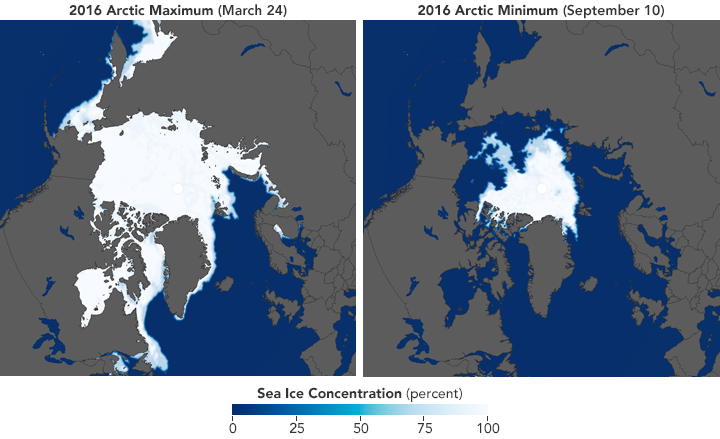On March 24 the National Snow and Ice Data Center NSIDC reported that the 20192020 growth season had an unexceptional finish. Each year scientists use multiple satellites and data sets to track how much of the Arctic Ocean is covered in sea ice but its thickness is harder to gauge.
This animation shows Arctic ice cover from 1978 to 2010.

Arctic ice cover. Ice coverage in the Arctic Ocean is currently the highest it has been since 2010 with support from the strongest polar vortex on record. NASAs ICESat-2 Measures Arctic Oceans Sea Ice Thickness Snow Cover Arctic sea ice helps keep Earth cool as its bright surface reflects the Suns energy back into space. An analysis of satellite data by NASA and the National Snow and Ice Data Center NSIDC at the University of Colorado Boulder shows that the 2020 minimum extent which was likely reached on Sept.
Ad Temporary covers for concerts events at ice arenas. This graph shows the average monthly Arctic sea ice extent each September. Seasonal ice having surpassed that of MYI in winter area coverage is now the dominant ice type shifting the Arctic ice cover into a new normal where the focus on understanding processes over first-year sea are as important as those over MYI ice Jeffries et al 2013.
Arctic sea ice extent in February was well below average but at the end of the month it was still higher than levels recorded in several recent years according to the US-based National Snow. The extent and area of the ice cover reached minima on 14 September 2007 at 41 10 6 km 2 and 36 10 6 km 2 respectivelyThese are 24 and 27 lower than the previous record lows both reached on 21 September 2005 and 37 and 38. Ice covers 54 million square miles of the Arctic.
1 Satellite data reveal unusually low Arctic sea ice coverage during the summer of 2007 caused in part by anomalously high temperatures and southerly winds. Arctic sea ice has likely reached its maximum extent for the year at 1477 million square kilometers 570 million square miles on March 21 2021 according to scientists at the National Snow and Ice Data Center NSIDC at the University of Colorado Boulder. The map above compares the 2012 Arctic sea ice minimum reached on September 17 with the 2020 Arctic sea ice minimum reached on September 15.
Ad Temporary covers for concerts events at ice arenas. 15 measured 144 million square miles 374 million square kilometers. 581 million square miles 1505 million square kilometers.
Arctic ice cover ice thickness and tipping points Ambio. Arctic sea ice reaches its minimum each September. After an uneventful winter freeze Arctic sea ice extent has passed its seasonal maximum and it is starting its annual melt the National Snow and Ice Data Center reported on Tuesday.
September Arctic sea ice is now declining at a rate of 131 percent per decade relative to the 1981 to 2010 average. Arctic sea ice extent had been shrinking at a relatively modest rate of 3-4 per decade annually av. The past five years have seen the lowest Arctic sea-ice extent since satellite measurements began in.
On this day the extent of the Arctic sea ice cover peaked at 1477 million square kilometers 570 million square miles making it the seventh-lowest on record tied with 2007. It was the 11 th-lowest maximum in the 42-year satellite record. Author Peter Wadhams 1 Affiliation.
What is now routine and uneventful for Arctic ice is a low maximum extent. For every month since last September when ice extent. Arctic sea ice extentthe area where ice concentration is at least 15 percentreached its apparent annual maximum on March 5 2020.
This years Arctic sea ice cover shrank to the second lowest extent since modern record-keeping began in the late 1970s. Light blue shading indicates the region where ice occurred in both 2012 and 2020 while white and medium blue areas show ice cover unique to 2012 and to 2020 respectively.
